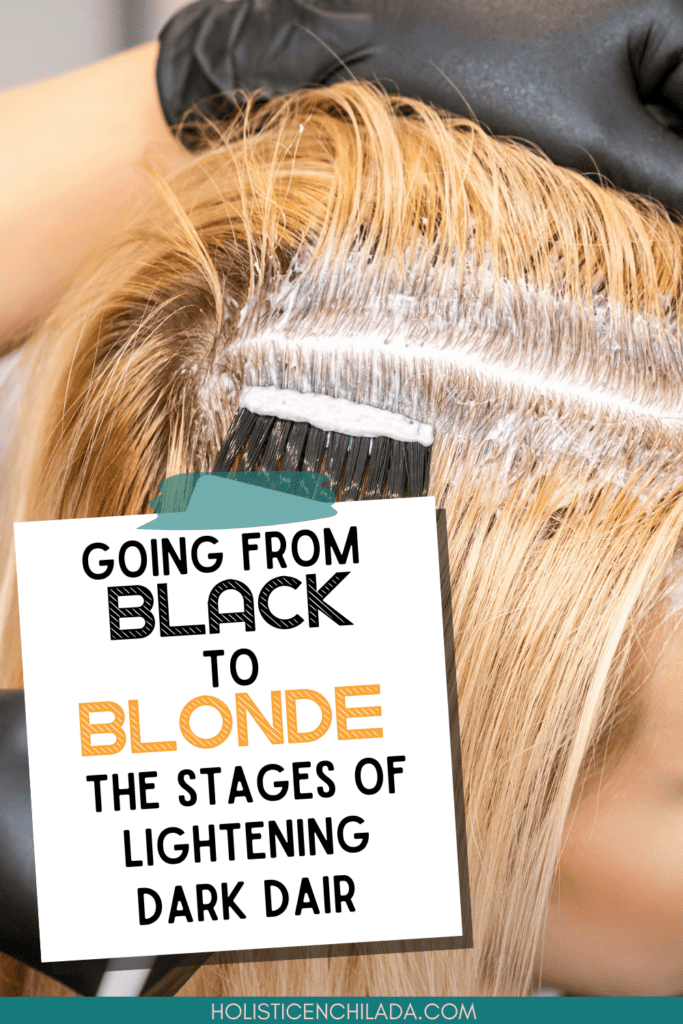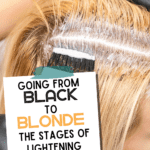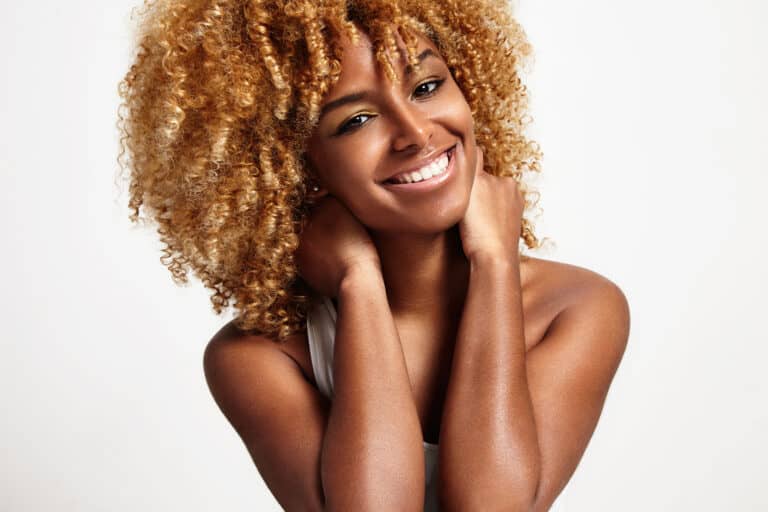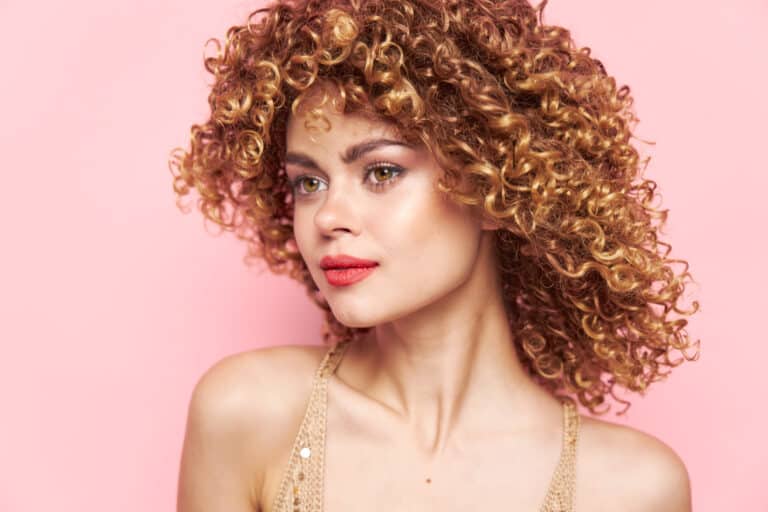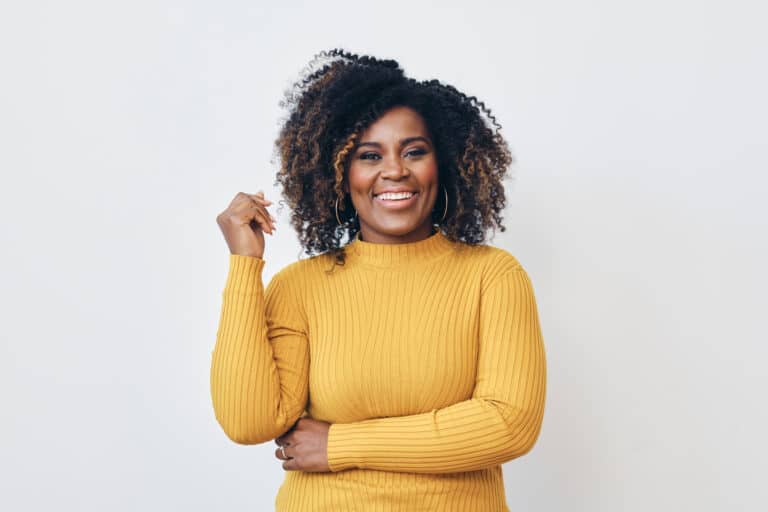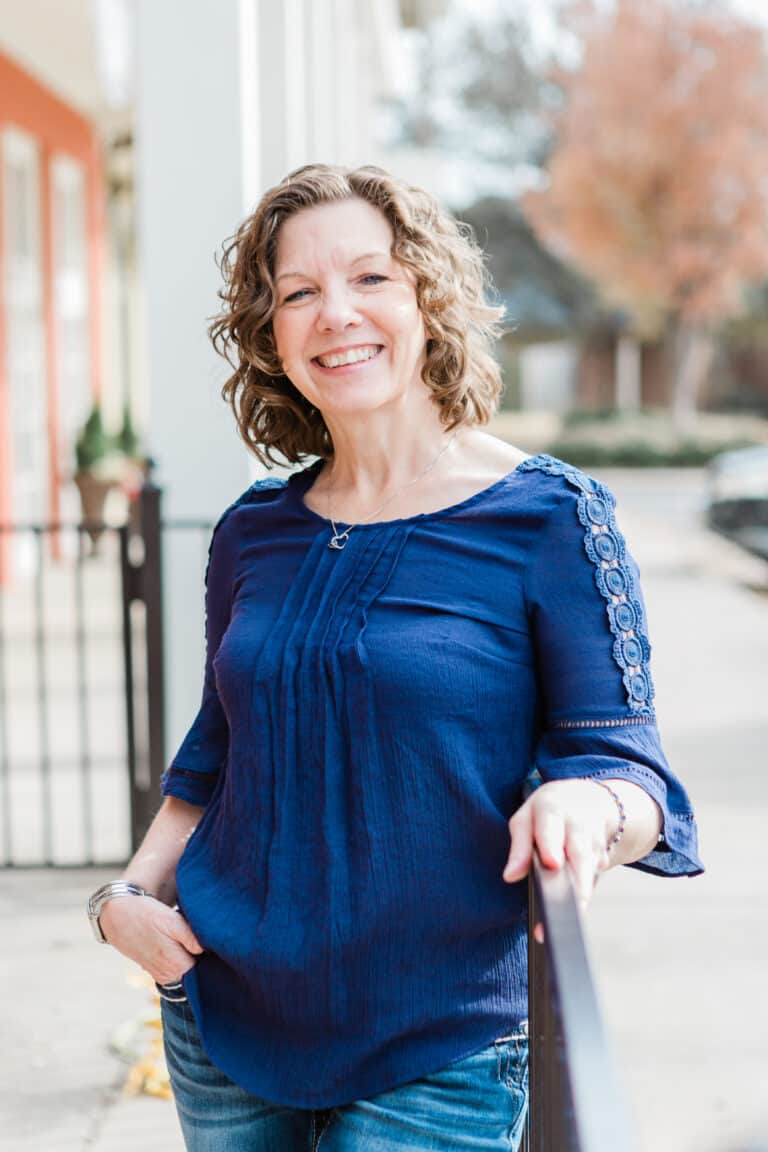From Black to Blonde: The Stages of Lightening Dark Hair
This post may contain affiliate links, and I will earn a commission if you purchase through these links. Please read the disclosure policy for more details.
Did you know there are seven stages of lightening dark hair? If you have dark locks and dream of being a platinum blonde or having mermaid tresses, it’s essential to understand the lightening process before you start, as this is the key to avoiding damaging your locks.
You’ll need to consider a few factors, like your hair porosity and the products you can use to lighten your hair. Knowing how to care for hair after lightening is also important, as the process can leave you with dry and fragile hair.
So in this guide, you’ll find all the information you need to transform your gorgeous dark hair into the blonde locks you’ve been dreaming of. We’ll share the different options for lightening hair, how to care for it afterward, and those all-important seven stages of lightening dark hair.

Hair Lightening Basics
Although lightening brunette hair is possible, you can’t just pile on the bleach and leave your hair until it’s the right shade. In fact, that’s a recipe for dry, frizzy hair that snaps as soon as you touch it!
Changing your hair color from dark to light without ruining your hair takes patience. Major color changes, like taking dark hair to platinum blonde, could take 6-12 months of salon appointments to reach your chosen color.
That’s quite a commitment, so you need to think carefully before starting the journey to platinum hair. Here are some of the main factors to bear in mind:
Virgin vs. Processed Hair
Virgin hair (unprocessed or natural hair) can be lightened with just one or two sessions, whereas processed hair needs to be lightened more cautiously over several sessions to avoid overprocessing.
Lightening color-treated hair is also more complicated as it can be a much lighter color at the ends than at the roots. This means that the lightening product will need to be left on for different lengths of time.
For best results, you should avoid any processing treatments before you lighten your hair. Professionals recommend leaving your hair to recover for about three months before lightening it.
Hair Levels
Hair color is described using Levels 1 to 10:
- Level 1: Black (darkest red undertones)
- Level 2: Brown/Black (dark red undertones)
- Level 3: Dark Brown (red undertones)
- Level 4: Medium Brown (red/orange undertones)
- Level 5: Light Brown (orange/red undertones)
- Level 6: Dark Blonde (orange undertones)
- Level 7: Medium Blonde (orange/yellow undertones)
- Level 8: Light Blonde (yellow/orange undertones)
- Level 9: Very Light Blonde (yellow undertone)
- Level 10: Lightest Blonde/Platinum/White (pale yellow undertones)
Before you lighten your hair, you need to know your current hair level and the level you aim to reach. The difference between these will determine how many levels you need to lift your hair color.
Choosing the Right Shade
If you don’t lighten your hair enough, the color you apply afterward won’t show up. If you lift your natural hair color too much, there won’t be enough pigment left in the strands for the color to grab hold of.
As a general rule, you need to go lighter for more vibrant or pastel colors, but Level 8 on the color scale is generally a good point to aim for. If you only want to apply a tint of color, Level 4 on the color scale is fine.
Porosity
Porosity describes how easily your hair absorbs and retains moisture and products. If you have high-porosity hair, your hair will absorb bleach faster than low-porosity hair. This means that it will get lighter more quickly, but it also means that it’s easier to cause severe damage to your locks.
Which do you have? Check out our Ultimate Guide to Hair Porosity to find out.
Processing Time
Leaving bleach on your hair for longer will give lighter results. So if you have lighter hair, you may only need to leave the product on your hair for 15-20 minutes, but darker hair can be left for up to 30 minutes.
Don’t leave bleach or any other hair lightening products on your locks for longer than 30 minutes, as this can cause serious damage to your hair. Instead, give your bleached hair time to recover from the process and then schedule another lightening session.
Product Type and Strength
Some products can lift color more easily than others, and this will determine how quickly your hair lightens. For example, a 20-volume developer will lift two levels, so it’s great for touching up roots. But a 30-volume developer can lift three or more levels, and a 40-volume will lift your hair color by as much as eight levels.
Carrying out a strand test will help you to decide how long you need to leave the product on. But to be sure you aren’t going to cause serious damage to your hair, it’s better to seek professional advice.
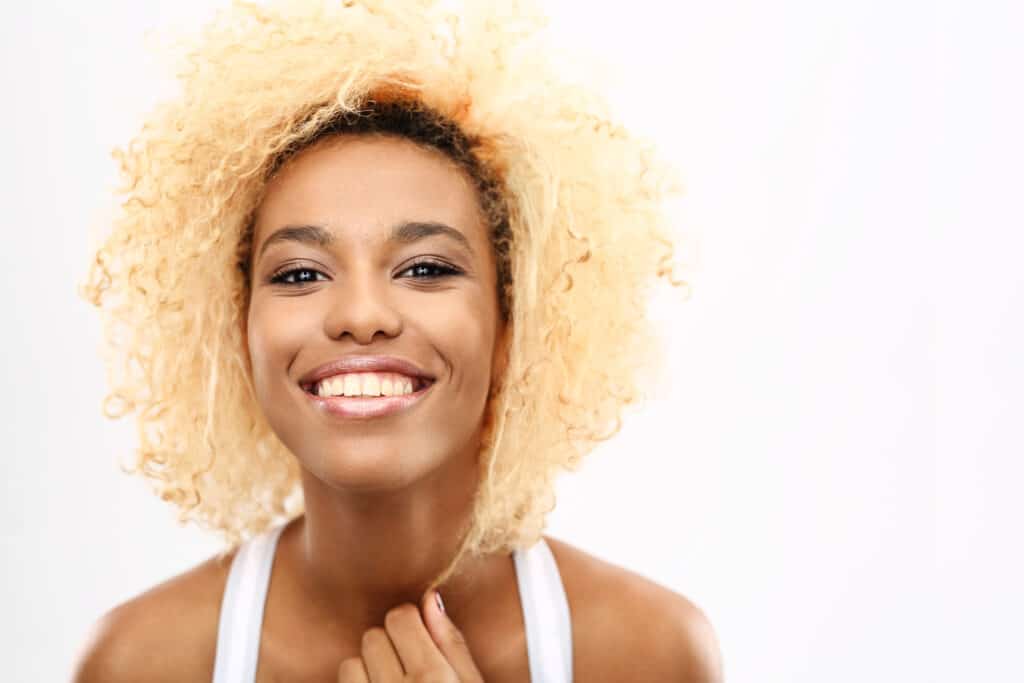
Lightening Dark Hair Strategies
There are several ways of lightening black hair, whether you go to a salon or do it yourself at home.
Natural Options
If you’d prefer to avoid bleach or hair dye, you’ll be happy to hear that there are some natural alternatives for lightening your hair. These include soaking your hair with a diluted apple cider vinegar rinse or using a paste of peroxide and baking soda to lighten your hair.
These may be gentler, but they also have more unpredictable results and won’t lighten your hair as much as bleach will. If you have hair that is damaged or color-treated, you should proceed with caution and may prefer to visit a professional.
Hair Dye
A box dye can lighten hair by 2 or 3 shades, but they will only work on your natural hair color and will dry out your hair.
Just using a box dye on its own isn’t as effective as lifting the color with bleach, but it won’t damage your hair as much, either.
Bleaching hair
Bleach is the most effective way to lighten dark hair, but it’s also a very aggressive process and the most damaging method.
Bleaching dark hair could take your natural hair color from Stage 1 to Stage 6 or 7 with just 2 or 3 bleaching sessions. However, the bleaching process will strip all moisture and natural protectant oils from your hair, leaving it dry, brittle, and likely to break.
Lightening Hair Professionally
Lightening is the process of dissolving and reducing pigments in the hair and can only be carried out on virgin hair.
Having your hair lightened professionally by an experienced stylist is the safest way to lighten your hair with minimal damage. They can also advise you on aftercare to keep your locks as soft and healthy as possible.

The 7 Stages of Lightening Hair
The number of steps in your own hair lightening process will depend on what hair color you have at the start of your hair coloring journey and how light you want your hair to be.
But in general, there are seven stages of lightening dark hair from black to platinum blonde:
Stage 1: Black Hair
Stage one is black or very dark brown, which is where many people start lightening hair.
You can only go lighter from here, and some permanent dyes will be effective. However, semi permanent dyes will only work if you use use bleach first.
Stage 2: Dark Brown Hair
Stage 2 will give you dark brown locks around level four. You can probably achieve this at home in one session with powder bleach and a 20-volume developer.
No dark brown pigments should be left at this point, but you may see red undertones. This will be a good base color for red or copper colors, or you could neutralize the red tones with a blue-based toner to give a cool ash-brown color.
Stage 3: Light Brown Hair
Stage 3 will take your hair to levels five or six, which is the most common result when you use a 30-volume developer on dark hair. You will still have some red undertones, and applying other colors over this shade can be difficult.
Stage 4: Dark Blonde Hair
Stage 4 will take you to levels 6-7. It can be tricky to tell the difference between light brown and dark blonde, but dark blonde (or dirty blonde) has yellow pigments compared to the red undertones in light brown hair. You can apply a strawberry blonde color over this shade of blonde.
Stage 5: Medium Blonde Hair
Medium blonde is around level eight, and this is where the true blondes begin, so pretty much any shade can be applied over this color.
You have probably been through several rounds of lightening by now, and damage may be starting to set in. You might want to visit a salon to ensure you get the right amount of lift and deal with any yellow pigments.
Stage 6: Light Blonde Hair
This stage of lightening your hair will take it to Level 9 on the color scale, and will allow you to apply pastel or silver colors.
Reaching Light Blonde at home is very tough to achieve without causing extreme dryness, breakage, and even hair loss.
Stage 7: Platinum Blonde Hair
The final stage is platinum or icy blonde. This is the very palest shade of blonde which can look stunning on some skin tones but doesn’t suit everyone.
Lightening your hair to this stage can cause a lot of irreversible damage, but a professional hair colorist will know how to lighten your hair with as little damage as possible.

Caring for Lightened Hair
You’ll likely see some damage from the chemicals used to lighten your hair. It may feel rough and dry, look frizzy and brittle, and you might see more breakage than usual in the worst cases.
Here are some simple tips for caring for lightened or bleached hair.
Fewer Hair Washes
Washing your hair can remove the natural sebum, causing your hair to dry out.
After lightening your hair, you want to keep as much moisture as possible, so shampooing less frequently will give your natural oils more time to travel down the strands from your scalp and replenish lost moisture.
Protein-Rich and Moisturizing Shampoo and Conditioner
Lightening your hair can remove moisture and protein from the hair strands, which causes it to lose elasticity. Alternating between protein-rich and moisturizing shampoo and conditioner will help to add moisture and protein back without causing an excess of either.
Redken Extreme Shampoo and Conditioner will help to replenish the lost protein from your already fragile hair, while the Maui Moisture Heal & Hydrate Shampoo and Conditioner will help to add moisture to your curls.
It’s also a good idea to use a weekly deep conditioner. This will penetrate the hair shaft to add moisture and nourish the hair, making it look healthier and reducing frizz.
Try using Marc Anthony Deep Conditioning Hair Mask, which contains caffeine, ginseng, and hydrolyzed keratin to restore shine, softness, and elasticity.
Limit Heat
Using heated styling tools will expose your fragile locks to even more damage. So it’s best to avoid using heat styling tools, flat irons, and blow dryers as much as possible.
If you really must use them, apply a heat protectant like CHI 44 Iron Guard Thermal Protection Spray first.
Regular Trims
Any chemical process can make your locks drier and causes more split ends than usual, which can then lead to further breakage.
It’s essential to have regular trims to remove split ends as soon as possible to keep breakage to a minimum.
Aftercare
Investing in intensive bond-building treatments is also a good idea, as it will rebuild the broken bonds and strengthen your hair. You can have this done at the salon or use Olaplex No 3 Hair Perfector at home.

Stages of Lightening Dark Hair FAQs
Now you know the basics of lightening dark hair, but if you still need more information, these frequently asked questions may help:
How Can You Bleach Dark Hair Without Turning it Orange?
Bleached hair will have undertones ranging from dark orange to pale yellow, depending on the shade of blonde. You can use a blue toner to neutralize these orange undertones in your bleached hair and leave your desired color. Using a purple shampoo or toner will help cancel out any yellow tones.
How Many Levels Can You Lighten Hair in One Session?
Most experts recommend lightening your hair by no more than four levels in one session. You should also leave 4-8 weeks between sessions and use a weekly deep conditioner between lightening sessions.
How Many Sessions Does It Take To Lighten Dark Hair?
This depends on how dark your natural hair is and how many shades lighter you want to take it. It will also depend on the condition of your hair, as you will need to leave longer between sessions if it is in poor condition.
In general, going from black to dark blonde will take two to three sessions and going from black to icy blonde will take up to seven sessions.
How Damaging Is Lightening Your Hair?
This will depend on the lightening method you use, the condition of your hair and how you care for your hair in between lightening sessions.
But hair experts agree that bleaching your hair will permanently damage the natural texture and condition of your locks.
The Best Way to Lighten Dark Hair: Key Takeaways
Lightening dark hair is certainly possible , but it takes care and patience and isn’t something that you should do on impulse. Rushing this kind of color change can cause serious damage to your locks.
Knowing your natural hair color level and the different stages of lightening jet black hair to icy blonde will help you to achieve the gorgeous color you are aiming for. You should also consider your hair porosity and the type of lightening product you plan to use.
Once you have all this information, you can work out the safest way to achieve gorgeous blonde locks and still have healthy hair.
Want To Remember This? Save From Black To Blonde: The Stages Of Lightening Dark Hair To Your Favorite Pinterest Board!
